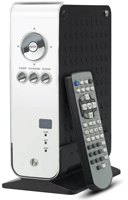Many of us watch video on our computers. But I reckon most of us would prefer to be reclined on the couch watching them on our TV instead. Sure, you can burn the content onto a DVD, but it’s time-consuming, and not really worth it for once-off viewing.
There are solutions though: Apple TV is one, though it’s been criticised for its poor picture quality and of course it’s somewhat tied to the iTunes ecosystem. And as far as I can see the most popular torrent formats such as DivX/XVid aren’t supported. (For when you’re playing those… umm… public domain movie torrents…)
The killer for me though is that it needs a widescreen TV. Call me a luddite, but I don’t have one yet. I’ve got a 5-year-old 4:3 TV that is doing just fine thanks, and I’m not planning on replacing it for a few years yet.
 Someone put me onto the Mediagate MG35, though admittedly I was primarily looking for a network shared drive at the time. This turns out, in a way, to be both a shared drive and a media player. Bonus. And when Zazz had it on special, I threw caution into the wind and ordered it. You can get them either without a drive (just install an IDE drive yourself) or with one already installed. I was feeling lazy and went for it with a 250Gb drive pre-installed (which beats the crap out of AppleTV’s 40Gb version…)
Someone put me onto the Mediagate MG35, though admittedly I was primarily looking for a network shared drive at the time. This turns out, in a way, to be both a shared drive and a media player. Bonus. And when Zazz had it on special, I threw caution into the wind and ordered it. You can get them either without a drive (just install an IDE drive yourself) or with one already installed. I was feeling lazy and went for it with a 250Gb drive pre-installed (which beats the crap out of AppleTV’s 40Gb version…)
It’s got a white Apple-like front, which doesn’t fit in brilliantly with my livingroom setup (mostly black, which I prefer, it fades into the background while watching telly) but given it’s not large, and the sides/back are black, it looks okay. A bright blue light goes on when it’s running, but you can choose to turn this off. It’s quiet, and fairly easy to setup. You either plug it via USB directly into your computer, or use an RJ-45 and plug it into a router. It picks up an IP address, and you’re away. (Note the manual warns against both USB and Ethernet connections simultaneously).
USB it happily sees the device as a drive, and you can copy files to/from it. By Ethernet you have to install a driver (which I’m fast realising is a disadvantage with most domestic-grade network drive devices) before you can copy files. USB is faster than Ethernet, but the other advantage of the Ethernet connection is that it can play files off a computer over the network, onto your TV, by creating a Shared Drive on your computer. There’s also a Wireless version if you prefer not to have blue cables trailing around your house.
(The manual is a bit vague about it, but it turns out the share needs to be accessible to one of the following username/password combinations: Guest / (blank); Administrator / (blank); Media / gate.)
It supports numerous formats including MPEG 1,2,4 and XVid, as well as various music formats and JPEG photos. I had some trouble with a couple of MP4 file I tried (an ABC “Vodcast”); it recognised them but wouldn’t play them, so that requires further investigation (and possibly the latest firmware). You choose which file(s) by browsing the device or a shared drive using a nice little remote control, powered by a watch battery.
Connection to the TV/stereo is by S-Video, optical, component or olde fashioned RCA/Composite.
And the playback quality? Well I’m no videophile, but I reckon the quality is pretty nice; very watchable, and the sound is good. Provided the source file is good, of course.
So all in all I’m very happy with it.![]()
The downsides? Not as many supported formats as the rival DLink DSM-320. In particular no WMV or MOV support, so protected legal movie/TV downloads will remain stuck on the computer.
Priced from A$190 (without HDD). Other cheaper variants such as the MG-25 (which is USB-only) are also still available.
